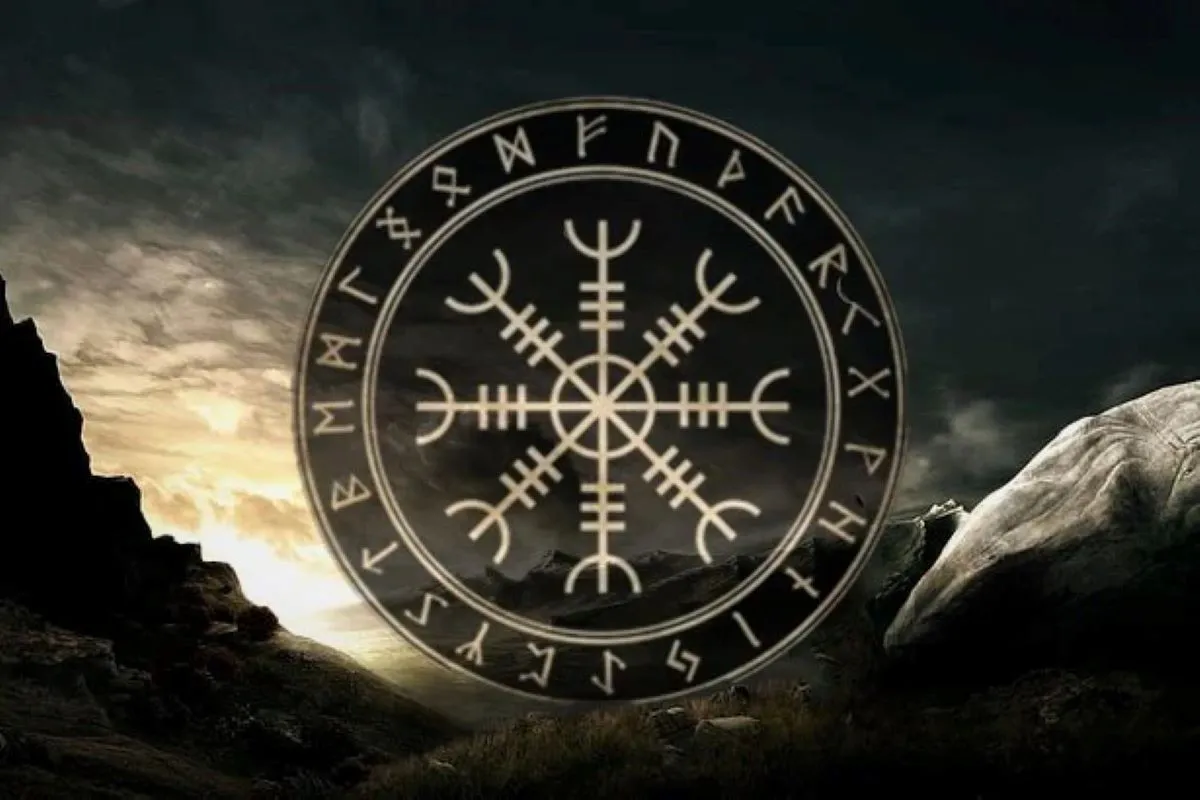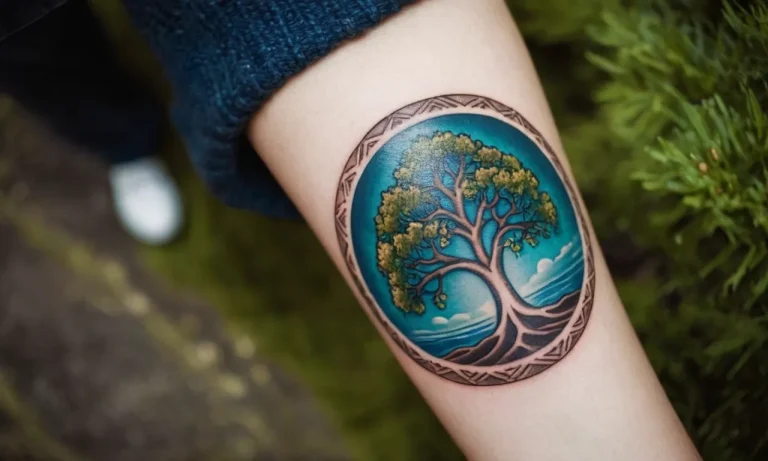The Helm Of Awe: Its Origins, Meaning, And Use In Christianity
The Helm of Awe is a Norse symbol that has become increasingly popular in recent years. With its intricate design of intersecting lines, it makes for an eye-catching tattoo or amulet. But what is the story behind this ancient symbol, and does it have meaning for Christians today?
If you’re short on time, here’s a quick answer to your question: The Helm of Awe originated in Norse mythology as a magical symbol worn between the eyes to induce fear and confusion among one’s enemies.
While it has no inherent Christian meaning, some Christians have adopted the symbol to represent God’s divine protection and the all-seeing nature of Christ’s love.
Origins and Meaning of the Helm of Awe in Norse Mythology
The Helm of Awe in the Poetic Edda
The Helm of Awe, also known as Ægishjálmur, is a powerful symbol in Norse mythology. It is prominently mentioned in the Poetic Edda, a collection of Old Norse poems that date back to the 13th century. The exact origins of the Helm of Awe are unclear, but it is believed to have been used by warriors and seafarers as a protective symbol.
In the Poetic Edda, the Helm of Awe is described as a magical symbol that grants its wearer great strength and courage. It is said to have been used by the god Odin himself, who was known as the Allfather and the ruler of the Norse gods.
The Helm of Awe was believed to have the power to instill fear in one’s enemies and protect the wearer from harm.
According to the Poetic Edda, the Helm of Awe was created by a dwarf named Ívaldi. The dwarf crafted the symbol out of the eyebrows of a giant named Ymir, imbuing it with magical properties. The Helm of Awe was then passed down through the generations, becoming a symbol of strength and protection in Norse mythology.
Symbolic Meaning as a Protective Symbol
The Helm of Awe holds significant symbolic meaning as a protective symbol in Norse mythology. It is often depicted as a circular shape with eight arms radiating outwards, forming a sort of compass design.
The symbol is usually depicted with a dot or a small circle in the center, representing the eye of Odin.
The Helm of Awe was believed to have the power to protect its wearer from both physical and spiritual harm. It was thought to ward off evil spirits, curses, and the influence of enemies. Warriors would often inscribe the symbol on their weapons or wear it as a talisman to bring them luck and protection in battle.
The Helm of Awe is still revered and used today as a symbol of strength and protection, not only in Norse mythology but also in modern culture. Many people wear jewelry or get tattoos of the Helm of Awe as a way to connect with their Norse heritage or as a symbol of personal strength and resilience.
For more information on the Helm of Awe and its significance in Norse mythology, you can visit https://norse-mythology.org/symbols/helm-of-awe-aegishjalmur/.
The Helm of Awe and Its Association with the Valknut
The Helm of Awe, also known as the Ægishjálmur or the Helm of Terror, is an ancient Icelandic symbol that has gained popularity in recent years. It is a powerful talisman that has deep roots in Norse mythology.
The symbol is made up of eight arms that radiate from a central point, creating a circular shape. Each arm is adorned with a runic symbol called the Ægishjálmur, which translates to “Helm of Awe.” The Helm of Awe is closely associated with the Valknut, another important symbol in Norse mythology.
Origins of the Helm of Awe
The exact origins of the Helm of Awe are unknown, but it is believed to have originated in ancient Norse culture. The symbol is often associated with the god Odin, who was known for his wisdom, knowledge, and magical powers.
It is said that Odin used the Helm of Awe to instill fear and awe in his enemies, hence its name. The symbol was often used on shields and helmets as a form of protection in battle. It was believed to have the power to both protect the wearer and strike fear into the hearts of their opponents.
Meaning of the Helm of Awe
The Helm of Awe is a symbol of power, strength, and protection. It is believed to provide its wearer with courage and the ability to overcome challenges. The symbol is often associated with bravery and fearlessness, qualities that were highly regarded in Norse culture.
It was believed that wearing or drawing the Helm of Awe would grant the wearer the strength and determination needed to face any obstacle or enemy.
Association with the Valknut
The Valknut is another ancient Norse symbol that is closely associated with the Helm of Awe. The Valknut, also known as the “Knot of the Slain,” is a symbol consisting of three interlocking triangles. It is often associated with the god Odin and is believed to represent his power over life and death.
The Valknut is often found in connection with depictions of Odin and is believed to be a symbol of his protection and guidance.
The Helm of Awe and the Valknut are often used together in modern interpretations of Norse mythology and paganism. The combination of these two powerful symbols is believed to amplify their protective and empowering qualities.
Today, many people wear jewelry or get tattoos of the Helm of Awe and the Valknut as a way to connect with their Norse heritage and channel their inner strength and courage.
To learn more about the Helm of Awe and its association with the Valknut, you can visit norse-mythology.org and ancient-symbols.com.
Adoption of Norse Symbols by Followers of Asatru
In recent years, there has been a noticeable revival of interest in Norse paganism, with many individuals identifying as followers of Asatru, an ancient Germanic religion. As part of their spiritual practice, these followers have embraced various Norse symbols, one of the most prominent being the Helm of Awe.
Revival of Interest in Norse Paganism
The resurgence of Norse paganism can be attributed to a variety of factors. One of the main reasons is a growing curiosity and desire to reconnect with ancestral roots and ancient traditions. Asatru, with its focus on the Norse gods and mythology, provides a means for individuals to explore their heritage and find a sense of belonging.
Furthermore, the popularity of Norse mythology in mainstream media, such as movies and television shows, has also contributed to the increased interest in Norse paganism. Characters like Thor and Loki have captured the imagination of many, prompting them to delve deeper into the rich lore and symbolism of the ancient Norse culture.
As followers of Asatru seek to honor their gods and ancestors, they have turned to various symbols and artifacts that hold deep meaning within Norse mythology. One such symbol is the Helm of Awe.
Use of Helm of Awe to Honor Norse Gods and Ancestors
The Helm of Awe, also known as Ægishjálmr, is an ancient Norse symbol that represents protection, strength, and courage. It consists of eight radiating arms that encircle a central point, often depicted as a dot or a small circle.
This powerful symbol is believed to have the ability to ward off evil and provide supernatural protection.
Followers of Asatru incorporate the Helm of Awe into their spiritual practices as a way to honor the Norse gods and their ancestors. By wearing or displaying this symbol, they seek to invoke the power and blessings of their deities, as well as pay homage to their lineage and heritage.
It is important to note that while the Helm of Awe has been adopted by followers of Asatru, it is not exclusive to this particular faith. The symbol has a long history and can be found in various contexts throughout Norse culture.
Its use in Christianity, for example, can be traced back to the Viking Age, where it was believed to bring protection and divine favor.
Christian Perspectives on Using the Helm of Awe Symbol
No Inherent Christian Meaning
From a Christian perspective, the Helm of Awe symbol does not inherently hold any specific meaning within the context of Christianity. The symbol, also known as Ægishjálmur in Old Norse, was primarily associated with Norse mythology and pagan beliefs.
It is important to note that symbols themselves are not inherently good or evil; instead, their meaning is derived from the intent and interpretation of those who use them. In the case of the Helm of Awe, it is crucial for Christians to understand its historical significance and potential associations before deciding to incorporate it into their faith.
Adoption for God’s Protection and Omniscience
Some Christians may choose to adopt the Helm of Awe symbol as a representation of God’s protection and omniscience. They see the symbol as a way to invoke God’s power and shield themselves from spiritual harm.
It is important, however, for Christians to remember that their ultimate source of protection and guidance comes from their faith in God and not from any external symbols or talismans. The Helm of Awe symbol can serve as a reminder of God’s strength and might, but it should never replace the central focus on God Himself.
Caution Against Pagan Associations
While some Christians may find personal meaning in the Helm of Awe symbol, it is essential to exercise caution regarding its potential pagan associations. The symbol’s origins and historical usage are deeply rooted in Norse mythology and pagan rituals.
Adopting symbols with pagan origins can blur the lines between Christianity and other belief systems, potentially diluting the Christian faith. It is crucial for Christians to prioritize their relationship with God and avoid any practices or symbols that may lead them away from His truth.
For more information on Christian symbolism and practices, you can visit www.christianity.com.
The Helm of Awe as a Popular Tattoo
Tattoos have become a popular form of self-expression, and one design that has caught the attention of many is the Helm of Awe. Derived from Norse mythology, this ancient symbol has gained significant popularity in recent years due to its unique and intricate design.
Let’s explore the appeal of Nordic tattoo designs and considerations for placement and size when choosing to ink the Helm of Awe.
Appeal of Nordic Tattoo Designs
Nordic tattoo designs have gained immense popularity due to their rich cultural heritage and the intricate details they offer. The Helm of Awe, also known as “Aegishjalmur,” is a symbol of protection and strength in Norse mythology.
Its symmetrical and visually striking design appeals to those seeking a tattoo that combines both aesthetic beauty and deep symbolism.
The Helm of Awe is often chosen by individuals who resonate with the values associated with Norse mythology, such as bravery, courage, and resilience. It serves as a constant reminder of one’s inner strength and the ability to overcome challenges.
Additionally, the historical significance of the symbol lends it an air of mystique and intrigue.
Many people are drawn to the Helm of Awe as it symbolizes protection. The interlocking arms of the symbol are believed to create a powerful defense mechanism against negative forces, making it a popular choice for those seeking spiritual or symbolic protection.
Considerations for Placement and Size
When choosing to get a Helm of Awe tattoo, it is essential to consider the placement and size of the design. The beauty of this symbol lies in its intricate details, so it is crucial to choose a location that allows for proper visibility and appreciation of the design.
A popular placement for the Helm of Awe tattoo is on the forearm, allowing for easy visibility and the opportunity to showcase the intricate details of the symbol. Other popular locations include the upper arm, chest, or back, where the size of the design can be larger and more detailed.
Size is another crucial consideration when getting a Helm of Awe tattoo. While some prefer a smaller, minimalist design, others opt for a larger, more elaborate depiction. The size of the tattoo can be influenced by personal preference, the desired level of detail, and the location on the body.
It is important to consult with a professional tattoo artist who specializes in Nordic designs to ensure that the Helm of Awe tattoo is executed with precision and attention to detail. They can provide guidance on the optimal size and placement based on your preferences and body anatomy.
Conclusion
While the Helm of Awe originated in Norse mythology, it has become popular far beyond those roots. For some Christians, its interwoven lines evoke themes of God’s protective power and omniscient vision. Yet other Christians and Norse pagans maintain its original mythological meanings.
Regardless of one’s religious beliefs, the Helm of Awe’s unique design and storied history give it widespread appeal as a distinctive tattoo.








